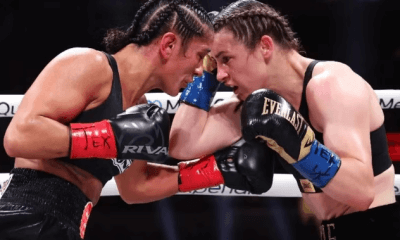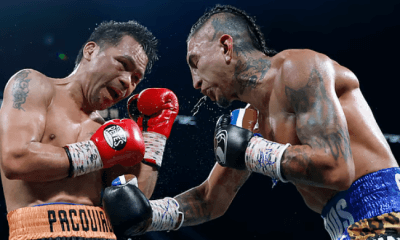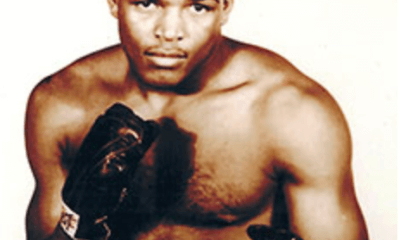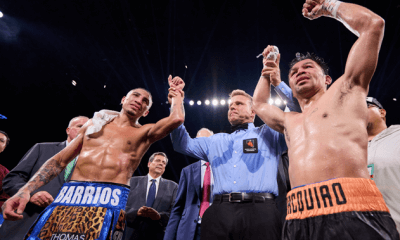Featured Articles
Battle Hymn – The Untold Story of Little Tiger Wade
SERIES INTRODUCTION
Many boxing historians will tell you the Golden Age began after New York passed the Walker Law in 1920 and ended in 1950, when local fight clubs closed and television ratings became a false arbiter of talent. During that thirty-year span, boxing took hold of American ideals and reinforced them six nights a week. To the sons of poor black migrants and second-generation immigrants, it offered spectacles that seemed to rise up out of the dust of a mythical past. It glorified the individual— global celebrities in the Roaring Twenties, archetypes for the Depression era, and real-life heroes during World War II. At least one boxing historian insists that no less than nine of the ten greatest fighters of the last century appeared in those three decades.
Aaron “Little Tiger” Wade, a San Francisco slugger you have probably never heard of, faced down two of them.
When Wade fought his way into the middleweight top ten in October 1945, he fought his way into the most dangerous division of the time. Jake LaMotta, rated third, had just lost a disputed split decision to arch-nemesis Sugar Ray Robinson (a decision he still disputes nearly seventy years later), while fourth-rated Rocky Graziano knocked out the welterweight champion twice that summer. Both were at their misanthropic peaks. On the throne was Tony Zale; the “Man of Steel” had just been released from military service and was gearing up to defend the title.
All of them were beset by a broiling pack of black fighters who came to be called “Murderers’ Row.”
Holman Williams was rated first, Charley Burley second, Wade was eighth, and Bert Lytell, whom Wade had defeated in September, was ninth. Zale, LaMotta, and Graziano were feeling the angry glare of half the row’s membership. They were lucky there weren’t more. Jack Chase was rated among them in March and would enter the light heavyweight ratings in October 1946. Cocoa Kid was there the previous month until he made the fateful mistake of fighting Archie Moore.
Archie Moore. Even then he was a beast. But he was a beast surrounded. Between 1942 and 1952, the only middleweights who beat him were Eddie Booker, Chase, Burley, Williams, and Wade — Murderers’ Row.
When they weren’t going after Moore (they got at him 18 times), they were going after each other. They had to; name-contenders were suspiciously unavailable and champions were hiding behind their thrones. Taken together, the 62 times they fought each other recall a battle royal from the bad old days. Every member of the row was black. They were all subsisting on what seemed like coins thrown by local promoters. Forced to trek across the continent in search of willing opponents, they would invariably run into fellow members in backwater arenas. They careened through brutal, bloody careers with false hope, blind-folded to the truth. They were desperate and it showed —in and out of the ring.
Only later did history look back and see the truth of their condemnation. Moore was the first. After they were gone, he carried on, bearing their scars and finally seizing a throne at the ripe old age of 36. He had them on his mind when he did. He began mentioning their names in interviews with awe and gratitude. Late in his career, he would get annoyed when reporters made their silly assumptions about the big noises he fought. When they stuck a microphone in his face and aimed their questions around Rocky Marciano to boost circulation, Moore wouldn’t oblige. Burley, he said. Booker.
Others followed Moore’s lead. Jim Murray said they were “the most exclusive men’s club the ring has ever known.” Budd Schulberg called them “that murderers’ row of Negro middleweights.” In the early 2000s, Allen S. Rosenfeld and Harry Otty published landmark biographies of Charley Burley. They did us another favor by expanding the spotlight to include Burley’s fiercest rivals, but found many of them shrouded in myth and misinformation. Murderers’ Row was a place of secrets.
In 2009, I took up Moore’s torch and became something of a private investigator hired by ghosts. My first project was Eddie Booker’s last fights. In 2010, Chasing Jack Chase was published, followed by Just Watch Mah Smoke: The Secret Journeys of Cocoa Kid in 2011 and The Beast of Stillman’s Gym in 2012. In between those, I collaborated with J.J. Johnston and Douglas Cavanaugh to unveil a film clip of Holman Williams in action.
Little Tiger Wade was at the dark end of the street. I couldn’t find him at first, his essence I mean. He had no criminal record like Chase, no military record like Cocoa Kid or Lytell, no film clip, and his troubles were private. His seventy-nine bout record, as listed on Boxrec.com, isn’t even complete. I found scraps of evidence pointing toward more, including a dusty statement by a reliable source claiming that Wade had exactly 152 professional bouts with a knockout percentage over 60%. I printed out sixty-eight newspaper fight reports on microfilm, though they lack detail and provided few leads.
For months, Wade remained a stranger. Then I found a retired postal worker in San Francisco named Alan Roy Wade. It was his son.
Wade turned professional in 1935 and had his last fight in 1950. He never got a shot at the title when the title was singular and had all the glory of a universal truth. His was an era of corruption and injustice, though at least then the sports writers could think linearly and didn’t tout make-pretend championships and silly belts. Wade looked up in a straight line and saw the middleweight throne shining in the distance. He pursued it with all of his powers. He never reached it, but he did what he could with what he had. And that’s all that can be asked of any man.
After his ring battles were behind him, he retreated into anonymity. I could found no evidence that he ever received an accolade for any of his life’s accomplishments, though there were many. He came close. In 1985, the Northern California Veteran Boxers’ Association planned to honor him for his contributions to boxing. An awards dinner was scheduled for April 12. He would have heard applause one more time. He would have been given a plaque and a club jacket with his name embroidered across the front. But he died two months earlier, and his widow received it instead.
Aaron Wade’s story has never been told.
Until now.
CHECK BACK SOON FOR PART 1 OF “BATTLE HYMN.”
Eye of the Tiger by Jakarutu (http://www.deviantart.com/art/Eye-of-the-Tiger-33901860).
“Golden Gloves History” note dated 1973 found in Chuck Burrough’s Scrapbook, courtesy of Peoria Public Library. Thanks to the International Boxing Research Organization.
Special thanks to Spider Joe Burke of the Northern California Veteran Boxers’ Association.
Springs Toledo can be contacted at scalinatella@hotmail.com.
-

 Featured Articles3 weeks ago
Featured Articles3 weeks agoResults and Recaps from New York Where Taylor Edged Serrano Once Again
-

 Featured Articles1 week ago
Featured Articles1 week agoThe Hauser Report: Zayas-Garcia, Pacquiao, Usyk, and the NYSAC
-

 Featured Articles3 weeks ago
Featured Articles3 weeks agoResults and Recaps from NYC where Hamzah Sheeraz was Spectacular
-

 Featured Articles2 days ago
Featured Articles2 days agoOscar Duarte and Regis Prograis Prevail on an Action-Packed Fight Card in Chicago
-

 Featured Articles4 weeks ago
Featured Articles4 weeks agoFrom a Sympathetic Figure to a Pariah: The Travails of Julio Cesar Chavez Jr
-

 Featured Articles2 weeks ago
Featured Articles2 weeks agoManny Pacquiao and Mario Barrios Fight to a Draw; Fundora stops Tim Tszyu
-

 Featured Articles3 weeks ago
Featured Articles3 weeks agoPhiladelphia Welterweight Gil Turner, a Phenom, Now Rests in an Unmarked Grave
-

 Featured Articles2 weeks ago
Featured Articles2 weeks agoArne’s Almanac: Pacquiao-Barrios Redux
















